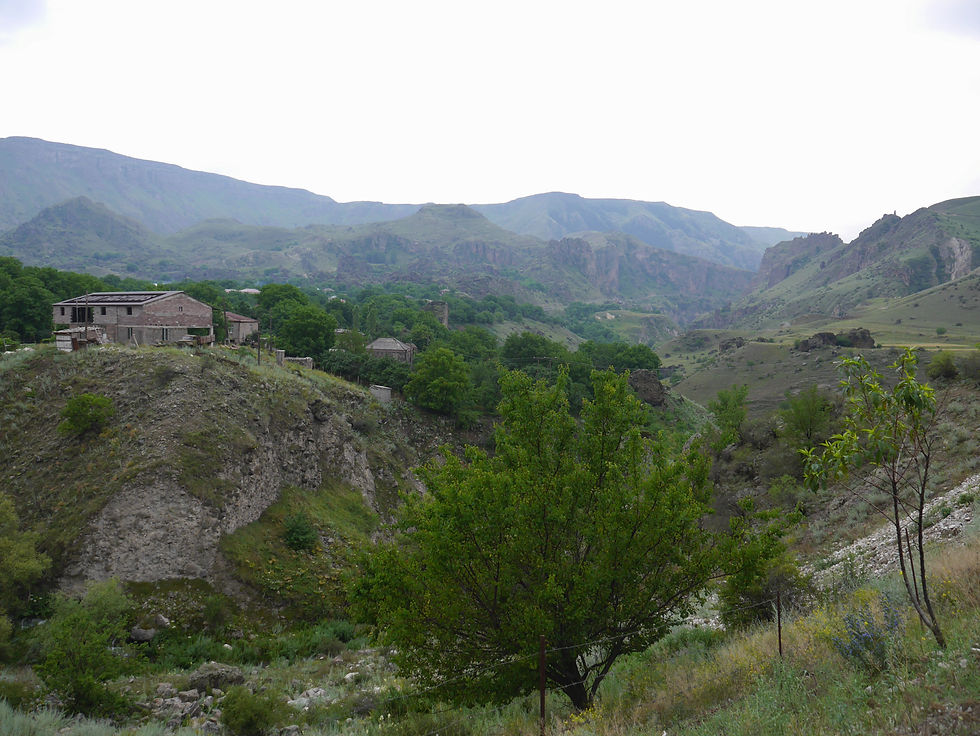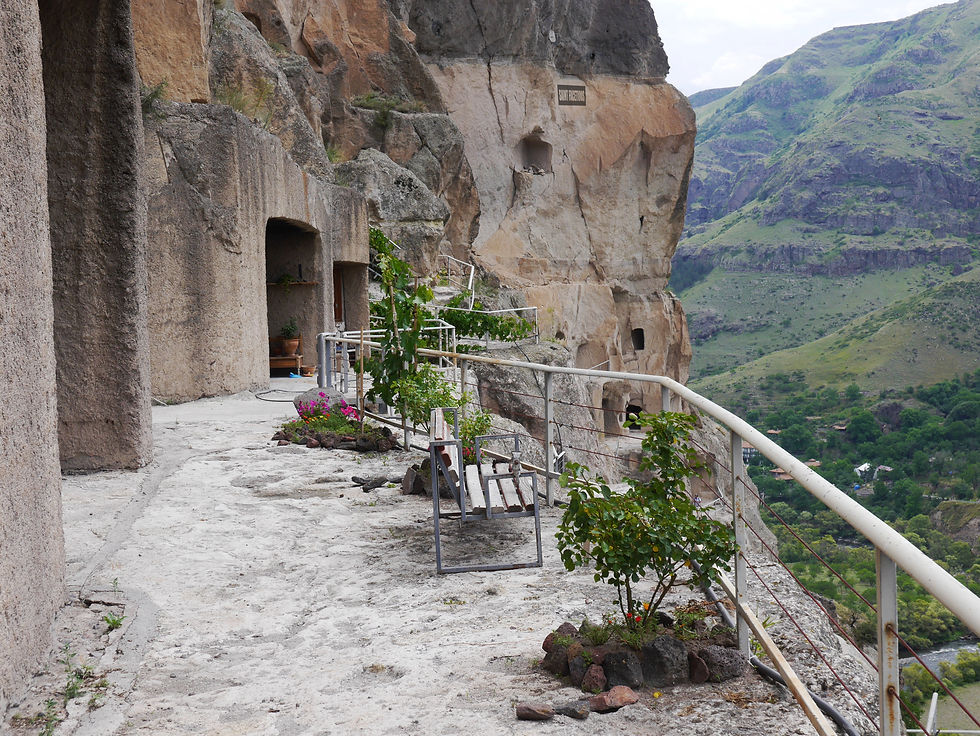- Shawn Basey

- Sep 3, 2019
- 7 min read

The day before we had had our failed quest to reach the megaliths of Paravani. We kept to our schedule and made it to the Vardzia area late at night, after eating at Akhalkalaki and a short pee-stop at a derailed train hanging over the river (and then a short search for where the hell the rail line whence that train car came from was).
The Guest House
I wish we had just pushed on and ate dinner at the place we were staying, Guest House Tirebi. When we arrived, the kitchen was still open, and guests were served in something of a great hall—stone walls and long wooden tables, the only thing killing the mood was the bright tiling. But it was all beautiful nevertheless. The kid was hungry, so we had some food brought out for him. From the American-style pancakes served in the morning though, I wish I had ordered dinner there was well. Terrific stuff.

At Guesthouse Tears
The family had started as hoteliers about ten years ago. They got a grant from the American government, and subsequently built two hotels by hand. The hotel we stayed at was right on the side of the highway to Vardzia, overlooking a small lake and with a nice view down the canyon to a random mountaintop castle. Her other hotel was on a small farm, whence they got all the produce and milk products they serve at both hotels. You can stay on the farm and help out, or stay in the upper hotel and not help with farm stuff. She plans on eventually teaching Georgian cooking classes (in Russian), and her son speaks fluent English, so don’t be afraid to call (+995 599 338 871).

The view from the guesthouse
They pick up from Tbilisi airport, a large Delica for 300 gel or a smaller jeep for 200 gel, with a direct transfer to their hotel. They also offer tours to Vardzia. Eating dinner and breakfast there, there’s definitely a great communal feel, and the owners come out and hang out quite frequently and are happy to chat with whoever can chat with them. You can tell they’ve put a lot of love into the place.
Vardzia
Vardzia is one of the more incredible places in Georgia, and must be on any list of “have-to-see” places. Logically, because of Georgia’s infrastructure, you often have to cut some places short, but definitely have it your list for one-of-the-times-you-visit Georgia. It’s about a four-hour drive from Tbilisi (3 hours, depending on how creative your driver is), but it’s well worth the trek, and can be combined with Borjomi, Akhalsitkhe, and Khertvisi, or as we did, you can take the route with the megaliths, which after the roads are finished, may actually end up being a faster route.

View from the start. Along with an sign for their patron saint.
Vardzia was founded as a cave monastery and as a refuge for civilians fleeing Turkish marauders (though caves there and in the area have shown some evidence of use since the Bronze Age, the actual rock cuttings and additional buildings weren’t until the Christian period). It was mostly built in the 1100s during Giorgi III and the reign his son King Tamar. The name supposedly comes from when Tamar was lost there as a child, and shouted to her uncle (or close man-friend), “I’m here, Uncle!”
Vardzia saw less use after Tamar’s victory over the Turks at the Battle of Basian, where she smashed the Seljuk Sultanate of Rum much like Ben Shapiro smashes homeless liberals on the streets of New York. The remains of the smashed Seljuks were brought back to Tbilisi, where they built a giant football stadium and nightclub underneath (true story).
The Seljuks laid off for a while, but Georgia finally succumbed to the hordes of Mongolians rolling through, ending suddenly their golden age (and everyone’s golden age as well, as that’s what Mongolians did best).
After a series of earthquakes crumbled most of the structures and fortifications in the 13th century, Vardzia fell to disuse and finally to Persians in the 1500s and the Ottomans just after.

The only structure that's really left.
When you wander around the half-cave structures, keep in mind that there used to be buildings standing on these foundations, which would have made the site of it completely different and much more magnificent. Not to say it’s not a grand site as it is, but these weren’t all patios, but also great halls, guestrooms, shops, bakeries, and so on, all the little things of a medieval market economy. There is one remaining tower in the center, which leaves you with a vague impression of how the other structures would have once looked back in the day.

Primitive toilets or cooking pits? You decide.
One recurring thing you’ll see are strange holes in the ground with a kind of slot on the side. This was so you could light a fire and set a big clay amphora on it to make a hearty stew or to heat up water. The hole served both the purpose of letting oxygen in and smoke out, along with allowing them to put a big stick in and use as a lever. You can also find a few marani rooms—wine cellars used for storing wines in underground amphorae (Georgian winemaking qvevri, to be precise).

The Church of the Dormition, the main attraction
The main site, the Church of the Dormition, was built during Tamar’s reign. The chapel is open to the cliff, with wall paintings on the outside. Entering in the church door reveals the main chapel, high domed and covered in medieval murals. Going through the other door leads to a small labyrinthine complex of tunnels. First there’s a chapel with some candles and icons. A corridor to the left leads to a spring, and the corridor up the stairs on the right goes to another small chapel-within-a-chapel, and further tunnels that exit out upper chambers.

The Bolnisi Cross surrounded by the Four Archangels

Icon of St. George, inside one of the chambers next to the Church
Outside of the Church, there are hundreds of caves with various living features, from cooking pots, to wine making, to shelves for an apothecary, to stables. With the maze of up and down staircases, one gets the feeling they’re in the movie Labyrinth, or perhaps an M.C. Escher painting.

You might end up upside-down and backwards in this array
Today there are several monks that still use the cave as their home. You can't enter where the monks actually live—it's railed off—but you can see the area which has a beautiful terrace full of green plants and flowers that they keep. The cable pulleys you see are still used to carry up supplies for the monks. As they have a nice private area, they're probably not too disturbed by all the tourists, but do show some respect around their grounds.

A modern monastery
The whole thing takes about 2 – 3 hours to see, if you’re in a hurry you could probably do it in one. Also keep in mind that you can take their little shuttle up to just below the main level of the site. That'll save you a ton of energy. I just walk it myself though to get the full feel of it.
Khertvisi Castle
If you’re visiting Vardzia, then it’s a sin if you miss Khertvisi Castle, Tamar’s primary castle of the area. It far predates that powerful King/Queen, its walls once standing (and falling) against Alexander the Great himself as he conquered Iberia. Sitting at the confluence of the Paravani and Mtkvari Rivers, the current fortress’s foundations were laid in the 2nd century BC and the walls in the 14th century, with the outer curtain wall added last year.

Alexander the Great once conquered this fortress
When I was first there, about 10 years ago, the place was a ruin, and the only people living there barely saw any living thing around there but cows and chickens. I walked up and inside and discovered it was being used as a mighty cow pen, with manure having fallen everywhere like snow on the mountain tops.

See the fancy tourism facility?
Now though, it has completely been renovated for tourism capacity. The village itself has come to life, with a small market, several beer gardens, a coffee shop, and a café. They’ve paved the road that goes up to the castle, kicked the cows out, built a wall to keep the cows out, and cleaned up all the manure. They’ve also built a visitor’s center, which just seems to serve as a place for someone to collect tickets (which are 5 lari each).

No more manure from ground up
There isn’t much else that’s been reconstructed, so don’t worry. Just the 14th century walls are standing, the interiors are just a very fertile ground. There’s a chapel in there supposedly from the 9th century. Be sure to light some candles.
There’s a fun story about that awkward square tower in the middle. Apparently, Tamar was holding a contest about who could build the most amazing tower for her fortress. A stonemason’s apprentice won the contest, so his master was so ashamed his student outdid him he jumped from the castle onto his well-placed knife and impaled himself on it.

A tower worth dying for
The student that won it decided to try out all the latest fashions in architecture and went with a square keep. They knocked him off so he couldn’t repeat his architectural wonder for anyone else (and so goes just about every architecture legend in the world, making one wonder why anyone ever studied a discipline that got you murdered, blinded, tongue-pulled-out, and so on).
Getting there
We of course went by car. You can take a car either from the Tsalka road (which right now is half under renovation) or from the Borjomi direction (which right now is half under renovation). The Tsalka route is probably a little bit shorter and to me, more interesting, what with those megaliths I was talking about in the last blog and all. If you are one of the un-carred masses, then you’ll have to ride a marshrutka from Akhalsitkhe (and get there by either marshrutka or train from Tbilisi). The marshrutkas leave three times a day, at 10:30, 13:00, 15:00 and cost 5 lari. The routes back are at the same time. If you want to get off to see Khertvisi, just shout the standard “gaucheret!” when the marshrutka turns off the main road and crosses a river.
The car we should have taken on this trip, from a rental company I can vouch for, Family Cars:
You can likewise take a taxi from Akhalsitkhe, and for a hundred lari get to also see Khertvisi and maybe Sapara Monastery if you have time (a very beautiful and sacred place, highly recommended).
A trip can be done in just one day, but that would probably limit you to only Vardzia. I’d highly recommend overnighting either at Tirebi on the road, or at Akhalsitkhe or Borjomi. That way you can also take in Khertvisi, Sapara, and Rabati Castle (my next blog).
Thanks for reading and hit the subscribe button below so you don’t miss a blog.



















